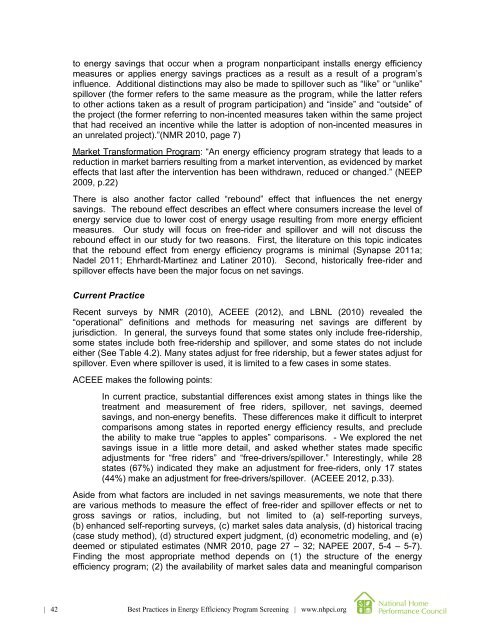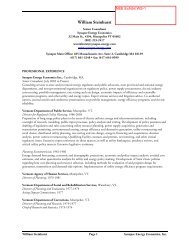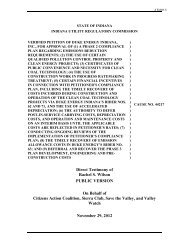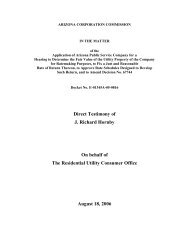Best Practices in Energy Efficiency Program Screening - Synapse ...
Best Practices in Energy Efficiency Program Screening - Synapse ...
Best Practices in Energy Efficiency Program Screening - Synapse ...
You also want an ePaper? Increase the reach of your titles
YUMPU automatically turns print PDFs into web optimized ePapers that Google loves.
to energy sav<strong>in</strong>gs that occur when a program nonparticipant <strong>in</strong>stalls energy efficiency<br />
measures or applies energy sav<strong>in</strong>gs practices as a result as a result of a program’s<br />
<strong>in</strong>fluence. Additional dist<strong>in</strong>ctions may also be made to spillover such as “like” or “unlike”<br />
spillover (the former refers to the same measure as the program, while the latter refers<br />
to other actions taken as a result of program participation) and “<strong>in</strong>side” and “outside” of<br />
the project (the former referr<strong>in</strong>g to non-<strong>in</strong>cented measures taken with<strong>in</strong> the same project<br />
that had received an <strong>in</strong>centive while the latter is adoption of non-<strong>in</strong>cented measures <strong>in</strong><br />
an unrelated project).”(NMR 2010, page 7)<br />
Market Transformation <strong>Program</strong>: “An energy efficiency program strategy that leads to a<br />
reduction <strong>in</strong> market barriers result<strong>in</strong>g from a market <strong>in</strong>tervention, as evidenced by market<br />
effects that last after the <strong>in</strong>tervention has been withdrawn, reduced or changed.” (NEEP<br />
2009, p.22)<br />
There is also another factor called “rebound” effect that <strong>in</strong>fluences the net energy<br />
sav<strong>in</strong>gs. The rebound effect describes an effect where consumers <strong>in</strong>crease the level of<br />
energy service due to lower cost of energy usage result<strong>in</strong>g from more energy efficient<br />
measures. Our study will focus on free-rider and spillover and will not discuss the<br />
rebound effect <strong>in</strong> our study for two reasons. First, the literature on this topic <strong>in</strong>dicates<br />
that the rebound effect from energy efficiency programs is m<strong>in</strong>imal (<strong>Synapse</strong> 2011a;<br />
Nadel 2011; Ehrhardt-Mart<strong>in</strong>ez and Lat<strong>in</strong>er 2010). Second, historically free-rider and<br />
spillover effects have been the major focus on net sav<strong>in</strong>gs.<br />
Current Practice<br />
Recent surveys by NMR (2010), ACEEE (2012), and LBNL (2010) revealed the<br />
“operational” def<strong>in</strong>itions and methods for measur<strong>in</strong>g net sav<strong>in</strong>gs are different by<br />
jurisdiction. In general, the surveys found that some states only <strong>in</strong>clude free-ridership,<br />
some states <strong>in</strong>clude both free-ridership and spillover, and some states do not <strong>in</strong>clude<br />
either (See Table 4.2). Many states adjust for free ridership, but a fewer states adjust for<br />
spillover. Even where spillover is used, it is limited to a few cases <strong>in</strong> some states.<br />
ACEEE makes the follow<strong>in</strong>g po<strong>in</strong>ts:<br />
In current practice, substantial differences exist among states <strong>in</strong> th<strong>in</strong>gs like the<br />
treatment and measurement of free riders, spillover, net sav<strong>in</strong>gs, deemed<br />
sav<strong>in</strong>gs, and non-energy benefits. These differences make it difficult to <strong>in</strong>terpret<br />
comparisons among states <strong>in</strong> reported energy efficiency results, and preclude<br />
the ability to make true “apples to apples” comparisons. - We explored the net<br />
sav<strong>in</strong>gs issue <strong>in</strong> a little more detail, and asked whether states made specific<br />
adjustments for “free riders” and “free-drivers/spillover.” Interest<strong>in</strong>gly, while 28<br />
states (67%) <strong>in</strong>dicated they make an adjustment for free-riders, only 17 states<br />
(44%) make an adjustment for free-drivers/spillover. (ACEEE 2012, p.33).<br />
Aside from what factors are <strong>in</strong>cluded <strong>in</strong> net sav<strong>in</strong>gs measurements, we note that there<br />
are various methods to measure the effect of free-rider and spillover effects or net to<br />
gross sav<strong>in</strong>gs or ratios, <strong>in</strong>clud<strong>in</strong>g, but not limited to (a) self-report<strong>in</strong>g surveys,<br />
(b) enhanced self-report<strong>in</strong>g surveys, (c) market sales data analysis, (d) historical trac<strong>in</strong>g<br />
(case study method), (d) structured expert judgment, (d) econometric model<strong>in</strong>g, and (e)<br />
deemed or stipulated estimates (NMR 2010, page 27 – 32; NAPEE 2007, 5-4 – 5-7).<br />
F<strong>in</strong>d<strong>in</strong>g the most appropriate method depends on (1) the structure of the energy<br />
efficiency program; (2) the availability of market sales data and mean<strong>in</strong>gful comparison<br />
| 42 <strong>Best</strong> <strong>Practices</strong> <strong>in</strong> <strong>Energy</strong> <strong>Efficiency</strong> <strong>Program</strong> Screen<strong>in</strong>g | www.nhpci.org







